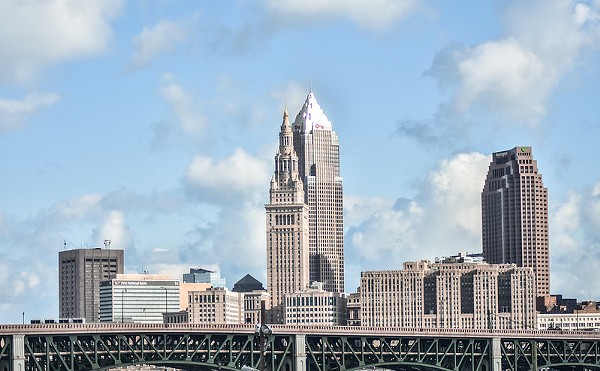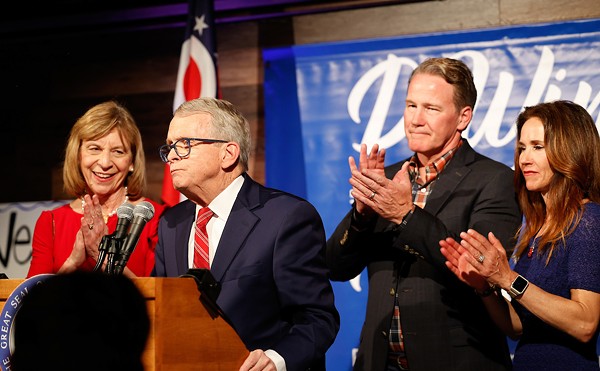Tom Dunderman of Basketeria Produce beams like a proud papa when he talks about his asparagus. He bought it from a small farmer he knows in Wellington, Ohio; it was just picked a few days ago, he boasts. Reaching out from behind his stand at the West Side Market, he holds up a bunch of the slender, blue-green beauties for you to see.
"I love this time of year," says Dunderman, who quit his job as a nurse 12 years ago to sell locally grown, organic vegetables at a West Side Market stand with his wife Anita. "A lot of times when we sell stuff to our customers, it's not even 24 hours off the vine."
Turn the corner and you'll see a different scene: kaleidoscopic mounds of produce similar to what you'd find in a big supermarket. They're typically conventionally grown, with chemical pesticides and fertilizers, and trucked in from outside Northeast Ohio. The bulk of it is purchased near downtown at the Northern Ohio Food Terminal, a hub where produce from coast to coast is distributed to restaurants and retailers.
This is the paradox of the West Side Market. It is Cleveland's greatest monument to local food, its majestic 137-foot clock tower and yellow brick marketplace providing shelter to more than 100 unique, locally owned businesses. Yet despite its history as a local-foods resource — an open-air farmers market was planted here at West 25th and Lorain as early as 1840 — much of what's sold here today isn't local.
"People love the old-fashioned counter service and the fact that market vendors have an intimate knowledge of what you'll be serving your family and how to serve it," says market manager Christine Zuniga-Eadie, who is working with city officials, vendors, and market leaders to bring in more local foods and to better market existing local options.
"But we're not yet an outstanding example of what our local food system can offer."
Advocates say that local foods are often fresher, healthier, better for the environment, and better for the local economy than the shipped-in goods found at most major stores. Typically, food in the U.S. travels 1,500 miles from farm to consumer. In contrast, locally raised foods make it from farm to plate in less than 100 miles.
"Adding more local foods at the West Side Market and marketing what's already there will support our economy and give customers what they want," says Jenita McGowan, chief of sustainability for the city of Cleveland and a leader of the Sustainable Cleveland 2019 initiative, which has declared 2012 the Year of Local Food.
With new farmers markets sprouting up across Northeast Ohio and the area being touted as a national leader in urban agriculture, the West Side Market could have an opportunity to become a hub for local foods, says Ward 3 Councilman Joe Cimperman.
"I don't need to buy garlic from China at the West Side Market, because I'm pretty sure garlic grows in Cleveland soil," he says. "A city-owned market should offer local food."
Challenges and Opportunities
Local foods are typically defined as those that are grown or raised within 100 miles of the location where they are sold. Local foods do not have to be organic, but many are.
Right now, there are four West Side Market produce vendors that regularly carry local produce, says Zuniga-Eadie: Basketeria, DeCaro Produce, Fritz's, and A&J Produce. Several other vendors carry local food products other than produce; those include Maple Valley Sugarbush (maple products), Ann Marie's Dairy (milk, cheese, eggs), Meister's Dairy, Foster's Meats (grass-fed beef), and Jorgenson's Apiary (honey).
A few produce vendors also carry locally grown produce sourced from the Northern Ohio Food Terminal during the summer, when it is often available. Additionally, many of the meat purveyors source their products from Ohio. Finally, bakeries and other specialty vendors inside the market like Ohio City Pasta make their products here and source ingredients from local suppliers.
If city leaders have their way, though, plenty more is coming. While Cleveland is celebrating the West Side Market Centennial with a series of parties and public events — including playing host to the prestigious International Public Markets Conference in September — leaders are grappling behind the scenes with myriad changes they say the venue must make to thrive for the next 100 years.
Some of the changes under debate are the addition of evening hours, making much-needed building improvements, and adding a community kitchen.
The push to add more local foods to the product mix is also on the table. "Part of keeping the West Side Market sustainable is to make sure that it stays relevant," says McGowan. "Our surveys show more demand for more local food."
Indeed, a 2011 report by the West Side Market Centennial Commission argues that promoting local foods is not only the right thing to do, but it will also help attract new customers and make the market more financially viable and sustainable in the long run.
"The West Side Market must continue to evolve to remain successful over the next 100 years," the report states. It goes on to argue that "increased customer demand for locally sourced product" is something that must be "addressed creatively."
Of course, like most centenarians, the West Side Market isn't exactly one to embrace change overnight. The idea of adding more local foods has been bandied about for years. The market is known for being a glorious throwback to simpler times, not for proactive change, and quarreling between the city and vendors hasn't helped the conversation move forward.
"The city is the world's worst landlord," says Vince Bertonaschi, the 23-year veteran of Vince's Meats and president of the West Side Market Tenants' Association. He says that the city has neglected tenants' needs for years and is only interested in making improvements now because the market is in the limelight during the Centennial.
Undeterred by blowback from vendors, the city nonetheless is rolling out efforts to market local foods and add more options. To entice local growers, they're offering new six-month leases which cost $300 to $500 per month and require four-day-per-week staffing (though some vendors do not open on Mondays — another source of controversy).
The city has also engaged Ohio City Inc., the local nonprofit development corporation, to help with marketing efforts, branding, and managing new projects.












